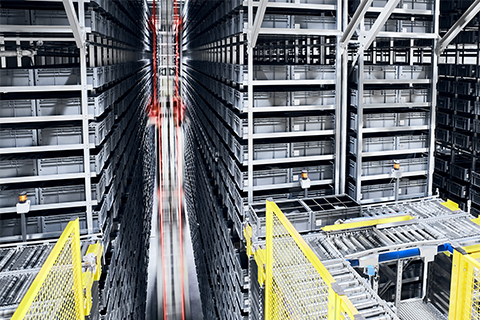Why you should not do without logistics consulting
Read more

When planning new construction projects or expansion measures in the field of intralogistics, the strategy of multiple-deep storage is often favored. But what exactly is behind this? For whom is double-deep storage suitable? And what requirements must be met for the principle to pay off and where does it reach its limits?
We will look into these and other questions! The focus will be on (Euro) pallets as loading aids.
To avoid any misunderstandings: Containers for storing small parts can also be stored in line with this strategy.
With double-deep storage, two pallets or containers are stored one behind the other in a dimensionally adapted shelf compartment.
Double-deep storage enables a high storage density, opens up capacities by eliminating aisles and their equipment and reduces acquisition and operating costs. Less space is required and a higher number of storage locations is possible with the same SRM movements.
For double-deep storage, a standardized product range with a low degree of individualization is recommended. Ideally, pallets with uniform article types are used.
The same applies to other multi-deep concepts (e.g. four-deep, eight-deep, etc.).
Advantages - qualitative and quantitative
When looking at the advantages of double-deep storage, for example, the high storage density scores first: By storing two storage units one behind the other in one and the same, correspondingly deep shelf compartment, the space requirement is significantly lower. At the same time, the number of aisles and storage and retrieval machines required for single-deep storage is reduced by 50 percent. As a result, the available space is better utilized thanks to double-deep storage.
These space-saving effects, which are becoming increasingly important in view of rising land and real estate prices and rents, also include lower investments in automation.
However, existing halls without expansion options can also be used perfectly and operating costs in later, operational business are much more moderate.
Restrictions and limits of double-deep storage
On the other hand, limited access options to the load units positioned in the second row can be limiting. This is because if such a pallet is requested for retrieval, the first pallet must first be retrieved or relocated. Consequently, the principle of multiple-deep storage is more suitable for a homogeneous to identical range of items . Pallets containing only one item, for which the regular call-off according to LIFO (Last-In, First-Out) is no problem at all, are virtually predestined for this. However, perishable goods with a best-before date (BBD) are largely excluded.
Without the use of suitable software, it is also not possible to achieve particularly high throughputs due to the lack of direct access to storage bins that are remote from the aisle. In contrast, fast access to the pallets in the first row with rapid goods turnover is also ensured by conventional means.
The importance of software for optimizing process organization
The good news is that the problem of difficult access to pallets in the second row can be largely compensated for by a warehouse management system (WMS) with an integrated material flow computer. This is because sophisticated algorithms, such as those offered by SAP EWM/MFS, the best-known standard solution for modern warehouse management and material flow control, solve the problem: here, for example, the software maps not only single but also double or multiple load handling devices on storage and retrieval machines .
Customized, analytical cycle time models can also be used in combination with intelligent operating strategies. Among other things, these make it possible to use specific storage strategies to reduce the number of stock transfers that would otherwise be necessary - for example, by creating material or delivery-only shelves during off-peak times. This also reduces travel times and empty runs.
The tried and tested ABC classification or "zoning" is also still a tried and tested means of aligning the performance in double-deep warehouses with that of a single-deep solution. This classification method is an (optimization) strategy in warehouse planning: goods are classified according to their value and turnover and arranged and distributed accordingly in the warehouse. A products are therefore the most important products and must be given priority.
When is multi-deep storage suitable?
Whether double-deep or multi-deep storage is worthwhile for a company is an individual decision that depends on several factors - but an analysis of the price/performance ratio is definitely worthwhile! This is because with multi-deep storage, far more storage locations can be created in a limited space than is possible with single-deep storage. In addition, throughput and availability can be further increased with software support if required. Users can use a conventional warehouse management system for this or exploit the full potential by using the standard SAP EWM (SAP Extended Warehouse Management) software, which is equipped with "an extra portion of intelligence".
In order to get the most out of warehouse performance, the IGZ Best Practice "Smart Slotting"is the most sensible addition. After all, if multi-deep storage is already highly beneficial, warehouse performance can be improved even further with the help of artificial intelligence (AI): For example, smart slotting using AI facilitates putaway with an intelligent storage location search. It uses an AI-supported evaluation of the data to decide in which area (ABC area, front/center/rear) a container/pallet should best be stored when it is placed in an (automated) warehouse.
If you need help in determining your optimum storage strategy or are interested in double or multi-deep storage, you are welcome to contact us at any time.
We look forward to hearing from you!